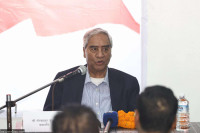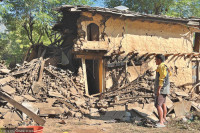Editorial
Women are discriminated against in the workplace
New and expectant mothers deserve all the help they can get. This would benefit the economy and society as a whole.
It is unfortunate that Nepal continues to miss out on effectively utilising more than one half of its population. This is because workplaces are still not tuned to suit the needs of women. Even as policymakers in Nepal claim to forward the cause of gender inclusion and progressiveness, actual implementation has been sorely lacking. While cases of gender inequality, such as those pertaining to citizenship rights, have received some coverage, what continues to lack any serious debate is the absence of provisions to accommodate women—especially expectant mothers and new mothers—in the workforce.
Women have been discriminated against in the workplace in more ways than one. There are numerous stories, globally, of women being discriminated against or losing their jobs because of their desire to become pregnant. Moreover, many new mothers find it almost impossible to rejoin the workplace after giving birth, especially because their work does not include features that facilitate a supportive environment for essential tasks such as nursing infants.
Nepal’s maternity leave provisions are not expected to be anywhere near the best in the world. Bulgaria, for instance, provides just under 59 weeks of paid leave for expectant mothers during and after pregnancy. But even compared to its neighbour India, which provides up to 26 weeks of paid maternity leave, and China, which mandates a national minimum of 98 days that is easily surpassed by provincial laws (over 200 days for Tibet and Guangdong, for example), Nepal lags far behind. This is because Nepal has provisioned for a maximum of 98 days of maternity leave, of which only 60 days are guaranteed to be fully paid by employers.
But what is worse is that women are losing out even on these meagre legally-provisioned support systems, either due to lack of knowledge about the provisions or due to fear of retribution. The example of a teacher at Tyud Secondary School in Kathmandu, who was forced to work through labour pains in August last year due to the principal’s harassment, and who subsequently lost her baby, may be an extreme case. However, many pregnant women from all walks of life have complained of the harsh conditions at work that make them quit their jobs altogether.
The Labour Act 1992 had provisioned for a crèche or playroom in workplaces with more than 50 women. These playrooms were supposed to have trained nurses employed, and be nursing friendly. However, not only were these facilities never applied—even by government offices—the Labour Act 2017 ended up removing them altogether. Even the federal Parliament—which definitely has over 50 women members—does not have any playroom installed.
Research conducted by the International Labour Organisation in 2014 showed how small and medium-sized enterprises stood to benefit by providing strong maternal protection. According to the Nepal Labour Force Survey 2017-18, the country is missing about 78 percent of women of employable age from the workforce. In a country that is experiencing a demographic dividend, and where women constitute over half of the total population, this is a massive loss—both economically and socially. However, unless maternity and post-partum support are not shored up—and enforced—Nepal will continue to lose out on the benefits of employing women.
But this issue goes beyond economics. Nepalis need to understand that to have a prosperous and healthy society, all its members need to feel protected and secure. Robbing the right of women to work and sustain themselves while they fulfil every citizen’s right to propagate will never lead to a happy and prosperous country.




 13.12°C Kathmandu
13.12°C Kathmandu












%20(1).jpg&w=300&height=200)

